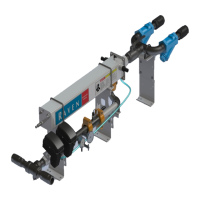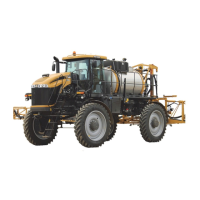CHAPTER 1
2 AccuFlow™ Vortex and AccuFlow™ HP+ Installation and Operation Manual
ANHYDROUS AMMONIA (NH
3
) SAFETY
Anhydrous ammonia (NH
3
) under pressure. NH
3
can cause severe burning, blindness, sickness, or death.
Understand all safety instructions and warnings before operating or servicing equipment.
• Review the properties of NH
3
and the procedures for safe handling, and use with your NH
3
supplier.
• Contact your NH
3
supplier or the appropriate agricultural department for training on handling,
transporting, transferring, and applying NH
3
. Training should be completed at least every three
years.
• Always wear appropriate personal protective equipment (PPE) when installing, inspecting, servicing,
and operating the NH3 system. Appropriate PPE includes, but is not limited to:
- Liquid proof gauntlet-style gloves impervious to NH3.
- Long sleeved shirt and long pants or protective suit.
- Indirect vent chemical splash goggles or indirect vent chemical splash goggles with full-face
shield.
• Check operation of system components (e.g. valves, temperature and pressure gages) prior to
charging the system with NH
3
.
• Seek immediate medical attention if symptoms of illness occur during or shortly after use of NH
3
products.
• Use extreme caution when servicing or maintaining a system that has previously been pressurized with NH
3
.
• Keep a source of clean water (at least five gallons) readily available while working with NH
3
. This
source should be in addition to, and separate from, the water source on the nurse tank.
• Read and follow instructions provided with the application system to properly discharge NH
3
before performing service or maintenance.
• Pressure gauges can fail, become plugged, or display incorrect pressure. Slowly bleed pressure
from a previously charged system by opening valves slightly. Allow pressure to discharge for an
extended period of time. Treat every section where NH
3
can be trapped as though it is pressurized.
• Thoroughly bleed all system lines and disconnect the nurse tank hose to remove NH
3
from the
system before transporting the system or beginning service or maintenance. Liquid NH
3
can
absorb heat from surroundings and re-pressurize the system. Any bleed valves that are opened to
relieve pressure should remain open while transporting the system or maintenance is being
performed.
• Stand ‘up wind’ when working around NH
3
and related equipment. Never work on NH
3
equipment
in confined spaces. Always keep NH
3
equipment away from buildings, livestock, and other people.
• Before each day's use:
- Visually inspect all system plumbing components for functionality, excessive wear, and damage.
- Some components may have recommended “replace by” dates or maximum service periods
regardless of visual condition.
- Replace individual components if excessively worn, visually damaged, or non-functioning, as
recommended by the component manufacturer, or as required by regulation, whichever is sooner.
- Test excess flow valves and document the date and result of tests. Replace any components that
do not pass inspection as needed.
• Never uncouple an NH
3
applicator or intermediate towing vehicle without appropriate parking
stands, wheel chocks, or other braking systems if a nurse take wagon is attached.
DANGER

